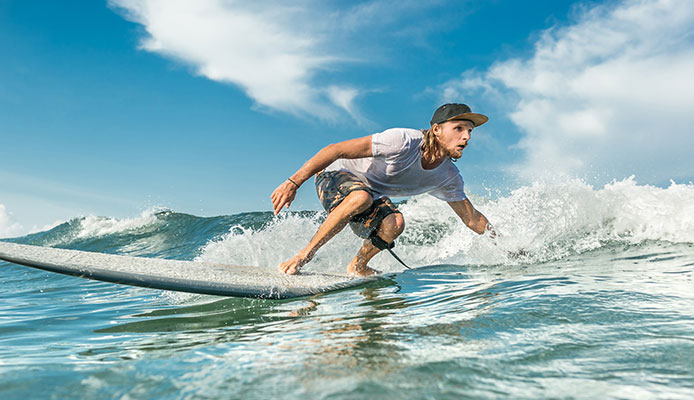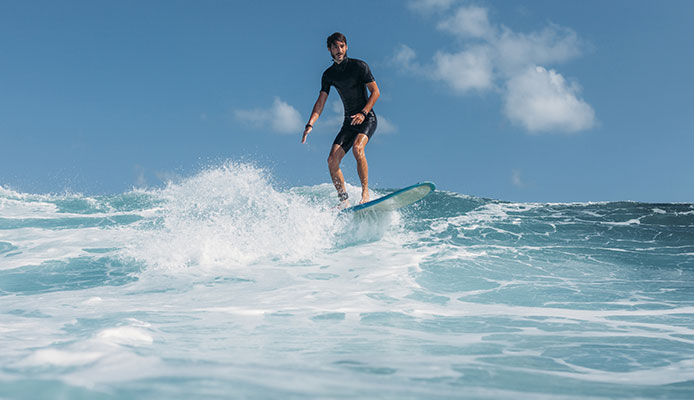
Bodyboarding and surfing are two of the most popular wave-riding sports. For a long time, there has been a huge rivalry between these two activities with many people debating about which one is better. They both use aboard, but other than that, bodyboarding and surfing are two different disciplines.
So, which one is better? What is easier? How are they different? Keep on reading this short post about bodyboarding vs surfing and learn from the insights we’ll share.
Comparing Bodyboarding vs Surfing
Now, let’s go straight to our comparison of surfing vs bodyboarding and talk about these two board sports. By the time you are done, it will be easier to pick the best water adventure to try!
1. How It Is Done
To discuss the basics of surfing vs bodyboarding, one of the best starting points is to look at how they are done.
Bodyboarding and surfing are both watersports that involve riding waves. However, you do it differently in the two sports. In bodyboarding, you ride waves in a prone position. When you are on a bodyboard, the waves are always breaking in over your head because you are lying. On the other hand, in surfing, you can ride waves in both prone and standing positions.
2. Ease of Riding a Board
If you are a newbie, it is better if you start with bodyboarding. It is easier to learn since you will stay in a prone position, unlike in surfing. Surfing tips and tricks are harder to master. Not only is bodyboarding easier, but it is also safer.
During the early years of wave riding, surfing is a sport that is somehow reserved for those who are experienced. It is for the elites or the kings of waves as some would say. In contrast, bodyboarding is more popular for those who are just learning, especially for children.
With bodyboarding, you can charge bigger waves easily because you are in a prone position. This means that you can enjoy better stability. This is against standing on a surfboard where you are prone to falling as waves get bigger. Nonetheless, if you know how to balance properly, this should not be much of a problem.
Because bodyboarding is easier, it is also preferred by older people or those who suffered from an injury. It demands less physical effort, but it is undeniable the bodyboarding is equally fun as surfing.
3. Type of Board Used
The board that is used is another important difference when it comes to bodyboarding vs surfing.
If you are concerned about price, then you will be happy to know that the best bodyboards are affordable. They are cheaper compared to surfboards, even those with exceptional quality.
When it comes to portability, bodyboards win! It is smaller and lighter compared to a surfboard, which means that it will be easy for you to bring around. A bodyboard can easily fit in the trunk of your car. On the other hand, for most types of surfboard, you need to strap it on the roof of your car. Bring your surfboard around the beach also requires considerably more effort because it is heavier.
The boards are also different in terms of their stiffness. Most bodyboards are made of stiffer materials, which will help them become more durable.
You might also like: What Is Bodyboarding? – Beginner’s
If there is one similarity between the two boards, it would be that they can remain close to you at all times. It is hard to lose them when you are in the water. Thanks to surfboard and bodyboard leashes, you won’t have a hard time chasing after your board!
4. Tricks and Techniques

If you would like to practice more stunts on a board, then surfing is the better option for you. One thing that makes surfing more challenging compared to bodyboarding is the plethora of tricks that you can do on a surfboard.
Once you are standing on a surfboard, there are many techniques that you can show off. Learning how to catch waves in surfing may not be easy, but once you get the hang of it, you will surely have a lot of fun doing a variety of tricks on your board.
5. Access to Waves
When talking about bodyboarding vs surfing, another important thing to note is that the two are different in terms of the waves that you will access. With bodyboards, you ride waves that surfers cannot access when standing up.
For instance, when you are bodyboarding, you can ride short breaks and super-hollow fast-breaking waves. When you are surfing, you won’t be able to access these waves. When waves become difficult it is impossible to stand and not lose balance, which is why bodyboarding is more forgiving.
Speaking of access to waves, there are also many restrictions on where you can go surfing. In blackball areas, you cannot enjoy surfing. In contrast, when you are bodyboarding, you can do it almost everywhere.
6. Health Benefits
Engaging in watersports is good for your mind and body. With this, the health benefits of surfing and bodyboarding are almost the same. Regardless of which you choose, you can expect that they will be both instrumental in better physical and mental health.
Notably, both bodyboarding and surfing can help tone muscles and build strength. They are also good for burning calories, improving mental health, and preventing cardiovascular diseases.
FAQ
Q: Is bodyboarding easier than surfing?
Yes, bodyboarding is easier than surfing. Bodyboarding is less physically demanding and has a shorter learning curve. Plus, bodyboards are also lightweight and easy to carry, unlike surfboards that can be a burden for some people. Bodyboarding is also often an introduction to learning the fundamentals of surfing.
Globo Surf Overview
In sum, as we talked about in this surfing vs bodyboarding article, the two are different in many ways. While they both involve riding waves and they deliver similar health benefits, they are not the same. From the type of board that is used to the techniques and tricks that are involved, bodyboarding and surfing are separate disciplines.

